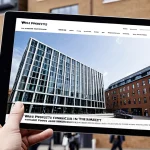Urban Development Trends in the UK
Urban development in the UK is evolving rapidly, driven by urbanisation UK patterns that concentrate growth in major UK cities such as London, Manchester, and Birmingham. These cities exhibit increasing demand for both commercial and residential spaces. The trend reflects a shift towards denser, mixed-use neighbourhoods where living, working, and leisure facilities coexist.
Government initiatives play a crucial role in shaping these patterns. Regeneration projects revitalise neglected areas through infrastructure investment and community engagement, often transforming brownfield sites into thriving hubs. This leads to improved quality of life and boosts real estate values. Additionally, there is a noticeable shift in commercial and residential zoning policies, facilitating higher density residential developments in previously commercial zones to meet urgent housing demands.
Have you seen this : Why Is Investing in UK Real Estate a Smart Financial Move?
These urban development trends reveal a dynamic landscape where municipalities actively steer growth to balance economic viability with sustainability, thereby influencing the broader real estate trends across UK cities. This creates opportunities for developers and investors who align with evolving zoning laws and regeneration priorities. Understanding these factors is essential for navigating the UK’s complex and promising urban property market.
Influence of Infrastructure on Real Estate Opportunities
Infrastructure improvements, especially new transport links UK, significantly influence urban development UK and real estate trends. Enhanced connectivity boosts both residential and commercial property values by making areas more accessible. For instance, the introduction of new rail lines or upgraded road networks opens up previously underdeveloped zones, attracting property investment and encouraging urban growth in UK cities.
In parallel : What are the opportunities in the UK commercial property market?
Transport projects create ripple effects that increase demand for housing near stations and commercial centres. This demand drives up prices and spurs development aligned with these new infrastructure assets. Government focus on integrating transport with urban planning ensures infrastructure acts as a catalyst rather than an afterthought in property market dynamics.
Major infrastructure developments like Crossrail in London demonstrate how strategic transport links can reshape real estate trends UK-wide by linking commuter belts with commercial hubs. These improvements reduce travel times and enhance quality of life, making connected areas desirable for investors and developers alike.
Understanding the interplay between infrastructure and urban development UK provides insight into emerging property investment hotspots, highlighting the value of connectivity in shaping future real estate opportunities across UK cities.
Policy and Regulation Shaping Urban Real Estate
Urban development UK is strongly influenced by UK property policy and evolving planning regulations. Governments implement key laws to guide growth, such as the National Planning Policy Framework, which emphasises balanced development while protecting green spaces. These policies set clear parameters for developers, helping to ensure projects align with long-term urban strategies.
Sustainable development is central to modern planning regulations. Green building standards now require energy efficiency and reduced carbon footprints in new constructions across UK cities. This shift encourages the use of innovative materials and technologies, ultimately making urban areas more resilient and attractive to environmentally conscious buyers and investors.
Tax incentives and policy reforms further impact real estate trends by motivating developers to prioritise sustainable and affordable housing projects. Incentives like reduced business rates or grants can accelerate regeneration efforts, particularly in underdeveloped zones. These regulatory measures collectively shape urban development UK by balancing economic growth with environmental and social objectives, thus guiding investors and developers in making informed decisions aligned with future market demands.
Emerging Real Estate Opportunities from Urban Expansion
Urban expansion in the UK is driving significant investment opportunities UK by transforming underutilised spaces through regeneration projects. Brownfield sites, often former industrial areas, are prime targets for redevelopment. These projects convert neglected lands into vibrant, mixed-use neighborhoods that combine residential, commercial, and leisure facilities. This approach meets rising housing demand and supports sustainable urban growth.
Mixed-use developments create attractive environments for residents and businesses, enhancing community life while increasing property values. For investors, these projects offer potential for long-term growth as revitalised areas become trendsetting urban hubs. Developers benefit from government incentives aimed at stimulating regeneration efforts, which help offset costs and encourage innovation.
Additionally, urban expansion improves connectivity and amenities in emerging districts, further raising demand. The combination of regeneration projects and urban expansion fosters diverse, economically viable communities across UK cities. This dynamic presents a wealth of opportunities for stakeholders seeking to leverage evolving real estate trends and capitalise on the ongoing transformation of urban landscapes.
Market Data and Case Studies
Recent real estate data UK highlights significant property value growth, particularly in areas benefiting from targeted urban regeneration. For example, cities like Manchester and Birmingham have seen residential prices appreciate due to extensive redevelopment and improved amenities. This aligns with broader property value trends indicating that well-connected, revitalised districts attract premium valuations.
Case studies UK reinforce these trends. Projects such as the regeneration of London’s King’s Cross demonstrate how coordinated investment and planning increase desirability, boosting both commercial and residential markets. These developments often integrate mixed-use spaces, enhancing livability and economic potential.
Regional variations are notable: London maintains a premium market, but northern cities are rapidly closing the gap thanks to strategic urban development UK initiatives. Investment opportunities in these regions are supported by government incentives and growing infrastructure, making them attractive to both developers and buyers.
Understanding this data provides clear evidence of how urban planning and regeneration directly affect market performance. Investors can leverage such insights to identify emerging hotspots and align strategies with evolving real estate trends in UK cities, optimising returns while contributing to sustainable urban growth.






